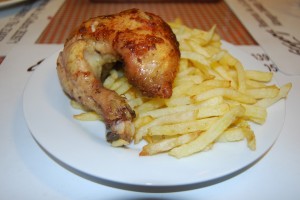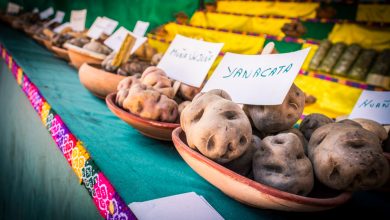Pollo a la Brasa, Urban Peru’s Favorite Food

Whole chickens slowly turn on a rack of spits that itself slowly makes a round over burning coals, or gas flame. This image saturates Peruvian cities, including Cuzco. Though it is not common in the tourist core–where whitewashed Spanish colonial buildings with orange tile roofs and carved wooden balconies shine in the sun above dark Inca walls of massive, finely carved stone — it fills the rest of Cuzco’s streets and shopping areas.
At lunch and dinner the many pollerías, as the places that specialize in pollo a la brasa (or chicken over coals) are called, are filled with Cuzco’s families devouring a fourth of a chicken on a mound of french fries, often with their hands. A marketing study claimed this rotisserie chicken is Peruvians’ “favorite” food. 56 % of Peruvians reportedly prefer, when they eat out, to have pollo a la brasa. The other common alternatives are ceviche and Chifa.
Once the province of Lima’s elites, this kind of chicken on a spit has become, during the last half of the twentieth century, one of the most popular foods in urban Peru. And, it is spreading outside Peru; for example, it is making inroads into the United States wherever there is a Peruvian community. In that is a story.
According to food historians, whole chickens roasted over coals have long been a Peruvian specialty especially for its elites. The chickens would be marinated, skewered on a pit, and rotated over hot coals by one of the many servants that worked in the manorial homes of Peru’s important families.
But, this was costly in time, since only a very small number of chickens could be roasted at a time. And it was relatively expensive, making it beyond the reach of most Peruvians.

To become a mass-market food, this would not do. And, these last fifty years of the twentieth century were when mass-market foods began to appear and take big chunks of the developing food market in the United States, Europe, and Peru.
Roger Schuler, a Swiss citizen resident in Peru, originated the idea of the multiple spits rotating in a round rack that also rotated over heat. Originally Schuler, according to his son Jimmy, unsuccessfully tried to raise chickens in a Peru that ate mature hens rather than young birds. To salvage his business, he began selling chicken roasted on a spit by the side of the Central Highway in the Chaclacayo and Los Cóndores neighborhoods inexpensively. Soon he had lines and realized he needed a better, more industrial, way to cook the chicken well.
He worked with Franz Ulrich who had a machine shop to design something that would work “like the planetary system”. Then, with Ulrich, he opened the original pollo a la braza restaurant, the Granja Azul in Lima.
Originally the chicken still was costly enough that it could not be consumed by the majority of the Peruvian population. Hen and chicken were traditionally elite foods.

But, in the 1980s, the cost of chicken fell — once democracy returned to Peru and the Shining Path Guerrilla movement began its armed rebellion — because of new import regulations which enabled the mass production of chickens. According to Jimmy Schuler, the birds for a good pollo a la brasa should be no more than 25 weeks old.
This was a propitious time for an inexpensive food for the new masses of Peruvians who were escaping the guerilla wars in the mountains and emigrating to Lima. The new food quickly caught on, saturated as it was with elite identity now available to all. It quickly spread to the entire country.
While there are some big chains of pollerías in Peru, such as Pardos Chicken, or Norkys, there are numerous ma and pa pollerías throughout the country. The big guys have not completely taken over the market.
As a result there is a wide variety of tastes in the chicken, though the basic dish is the same through out the country, roasted chicken, french fries (except in the jungle where they fry yuca), and salad. Although the original recipe used by Schuler flavored the chicken with just some salt, now there are many kinds of marinade used before hand as well as seasonings applied to the pre-cooked skin. Another source of flavor difference is the kind of coals, wood, or gas flame used as a heat source. Each brings a distinctive flavor. Traditionally, the preferred in Lima is algarrobo wood.
Pollo a la brasa has become so generalized in Peru and so symbolically Peruvian, that Peru’s National Institute of Culture, given its efforts to document Peruvian folkways and bring attention to Peru’s cuisine, declared in 2004 that pollo a la brasa is a “National Culinary Specialty” of Peru. Furthermore, the national government set aside the third Sunday in June beginning in 2010 as national Pollo a La Brasa Day to celebrate this symbolically important Peruvian food and to promote its increased sales. In all of Peru, sales of pollo a la brasa may already bring in as much as 600 million US dollars.
No matter the power of modern markets and the mass publics they create, it is still a delight to enter a pollería filled with families and order one’s own chicken and fries. While you can indulge in the nicety of a knife and fork, you can also just lift the bird up and eat it.
Eating with the hands is also something important here; it marks the breakdown of formality that used to dominate traditional Peruvian urban society, while eating with the hands was common in the countryside and among many rural people who now lived in the city. Pollo a la brasa allows all to eat directly from their hands, whatever their social standing. It is an invocation of contemporary Peruvian society as one big voting and buying block, and how tasty an invocation it is.

In the colonial area of Cuzco, there are some thirteen pollerías to choose from (there are magnitudes more outside the colonial area). While there is one representative of the national chain Norkys (Avenida Garcilaso 198), close to the Main Square (on Almagro Street) there are two pollerías side by side where many tourists dine: Los Toldos and Etapoy.
They are both good, and classically Peruvian. We did find the chicken at Los Toldos to be more savory, although both were plump and juicy with crispy skin. Either one is a good bet if you wish to try this rapidly growing part of Peruvian food culture. If some of your party wish other dishes, both also have an extensive menu of other grilled meats, as well as pastas, as well as extensive salad bars.
Recipes in English for pollos a la brasa, should you wish to try to make it at home without the planetary system are found here, here, and here.





Thanks for another fantastic post. Where else could anyone get that kind of info in such an ideal way of writing? I’ve a presentation subsequent week, and I am on the search for such info.